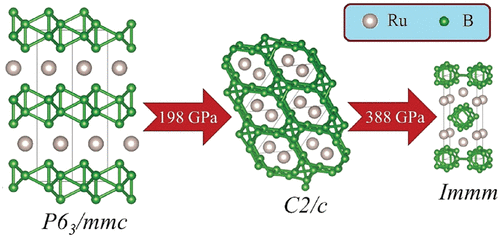当前位置:
X-MOL 学术
›
J. Phys. Chem. C
›
论文详情
Our official English website, www.x-mol.net, welcomes your
feedback! (Note: you will need to create a separate account there.)
Structural Phase Transitions, Electronic Properties, and Hardness of RuB4 under High Pressure in Comparison with FeB4 and OsB4
The Journal of Physical Chemistry C ( IF 3.3 ) Pub Date : 2020-06-15 , DOI: 10.1021/acs.jpcc.0c03959 Komsilp Kotmool 1, 2 , Prutthipong Tsuppayakorn-aek 3, 4 , Thanayut Kaewmaraya , Udomsilp Pinsook 3, 4 , Rajeev Ahuja 5 , Thiti Bovornratanaraks 3, 4
The Journal of Physical Chemistry C ( IF 3.3 ) Pub Date : 2020-06-15 , DOI: 10.1021/acs.jpcc.0c03959 Komsilp Kotmool 1, 2 , Prutthipong Tsuppayakorn-aek 3, 4 , Thanayut Kaewmaraya , Udomsilp Pinsook 3, 4 , Rajeev Ahuja 5 , Thiti Bovornratanaraks 3, 4
Affiliation

|
We have employed an evolutionary algorithm with first-principles calculations to investigate the pressure-induced structural evolution of RuB4 up to 500 GPa. The ambient phase is predicted to be a hexagonal structure (P63/mmc). The novel phases consisting of monoclinic (C2/c) and orthorhombic (Immm) structures are proposed to be the high-pressure phases at the pressure intervals of 198–388 GPa and beyond 388 GPa, respectively. The stability of the predicted phases is confirmed by both dynamic and elastic calculations. The electronic and mechanical properties of the predicted phases are evaluated and mainly discussed compared to the isoelectronic metal tetraborides, i.e., FeB4 and OsB4. In contrast to FeB4 and OsB4, all the stable phases of RuB4 are metal or semimetal, and any semiconducting phases do not emerge in the transformation pathway of RuB4. The nature of chemical bonding investigated by ELF, MPA, and pCOHP calculations reveals that the atomic configurations and the degree of covalent bonding of the predicted phases are responsible for lower hardness compared to those of FeB4 and OsB4. The results of this work provide more understanding of the family of metal tetraboride for designing metal-boride-based hard/superhard materials.
中文翻译:

与FeB 4和OsB 4相比,高压下RuB 4的结构相变,电子性质和硬度
我们采用了具有第一性原理计算的演化算法,以研究压力诱导的高达500 GPa的RuB 4的结构演化。预计环境相为六方结构(P 6 3 / mmc)。由单斜(C 2 / c)和斜晶(Immm)组成的新相。)结构被建议为分别在198–388 GPa和超过388 GPa压力区间的高压相。预测相的稳定性通过动态和弹性计算得到确认。与等电金属四硼化物即FeB 4和OsB 4相比,对预测相的电子和机械性能进行了评估和讨论。与此相反的FeB 4和OSB 4,擦的所有稳定相4是金属或半金属,任何半导体阶段不擦转型过程出现4。通过ELF,MPA和pCOHP计算研究出的化学键合性质表明,与FeB 4和OsB 4相比,预测相的原子构型和共价键合度降低了硬度。这项工作的结果为设计基于金属硼化物的硬/超硬材料提供了对四硼化金属家族的更多了解。
更新日期:2020-07-09
中文翻译:

与FeB 4和OsB 4相比,高压下RuB 4的结构相变,电子性质和硬度
我们采用了具有第一性原理计算的演化算法,以研究压力诱导的高达500 GPa的RuB 4的结构演化。预计环境相为六方结构(P 6 3 / mmc)。由单斜(C 2 / c)和斜晶(Immm)组成的新相。)结构被建议为分别在198–388 GPa和超过388 GPa压力区间的高压相。预测相的稳定性通过动态和弹性计算得到确认。与等电金属四硼化物即FeB 4和OsB 4相比,对预测相的电子和机械性能进行了评估和讨论。与此相反的FeB 4和OSB 4,擦的所有稳定相4是金属或半金属,任何半导体阶段不擦转型过程出现4。通过ELF,MPA和pCOHP计算研究出的化学键合性质表明,与FeB 4和OsB 4相比,预测相的原子构型和共价键合度降低了硬度。这项工作的结果为设计基于金属硼化物的硬/超硬材料提供了对四硼化金属家族的更多了解。











































 京公网安备 11010802027423号
京公网安备 11010802027423号